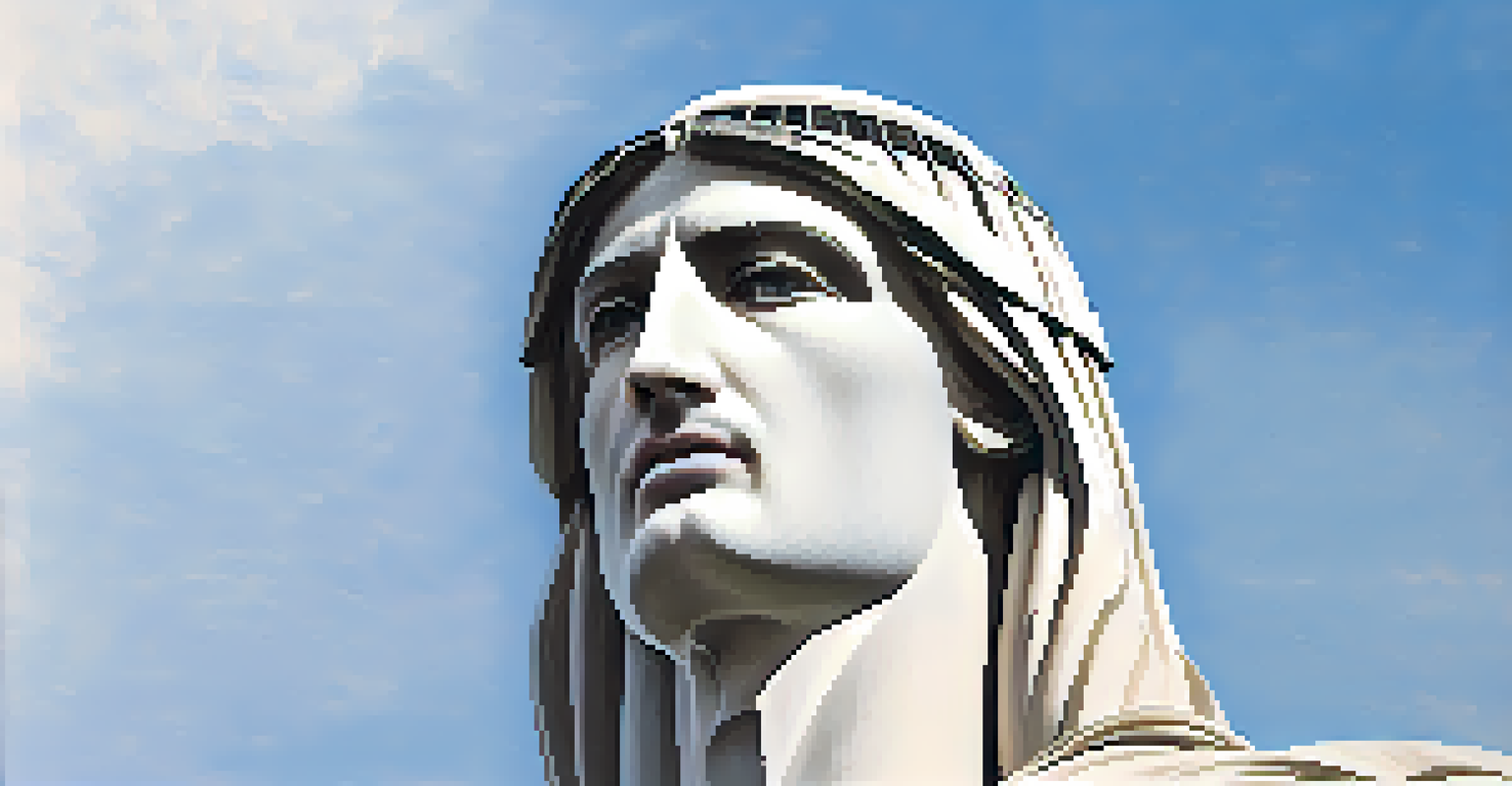Christ the Redeemer: A Symbol of Faith and Hope

The History Behind Christ the Redeemer's Construction
Christ the Redeemer, an iconic statue overlooking Rio de Janeiro, was completed in 1931. Designed by French sculptor Paul Landowski and engineer Heitor da Silva Costa, it took nearly a decade to bring this vision to life. The statue stands 98 feet tall, with arms stretched wide, symbolizing an embrace of the city and its people. The project was a monumental effort involving both Brazilian and French artisans, showcasing the country's dedication to faith and artistry.
Faith is taking the first step even when you don't see the whole staircase.
The inspiration for the statue came from a desire to create a symbol of Christianity that would stand proudly in Brazil. The project's location atop Corcovado Mountain was chosen for its breathtaking views and its spiritual significance. As construction began, it faced challenges such as weather conditions and funding shortages, yet the community rallied to support this ambitious endeavor. This collaboration not only created a statue but also fostered a sense of national pride.
Today, Christ the Redeemer is not only a religious symbol but also a UNESCO World Heritage site, attracting millions of visitors each year. Its enduring presence serves as a reminder of the faith that inspired its creation and the hope it represents for many. The statue's construction story reflects the power of community and belief, making it a cherished landmark in Brazilian culture.
Symbolism of Christ the Redeemer in Christianity
The statue of Christ the Redeemer embodies the core tenets of Christianity, primarily love, acceptance, and redemption. Its open arms symbolize the welcoming nature of Jesus, inviting everyone to experience faith regardless of their background. This portrayal resonates deeply with believers, reminding them of their faith's inclusive message, which is central to many Christian teachings.

Moreover, the statue stands as a beacon of hope in times of despair. Many people find solace in its presence, viewing it as a physical manifestation of divine love and protection. Pilgrims and tourists alike often express a sense of peace when visiting, reinforcing the idea that faith can provide comfort even in challenging times.
Construction Symbolizes Unity
The creation of Christ the Redeemer involved a collaborative effort from Brazilian and French artisans, embodying community spirit and national pride.
In various religious events, the statue serves as a backdrop for ceremonies, prayers, and gatherings, further solidifying its role as a spiritual symbol. Its significance goes beyond mere aesthetics; it acts as a reminder of the values that bind the Christian community together. The statue's message of hope continues to inspire countless individuals on their spiritual journeys.
Cultural Impact of Christ the Redeemer
Christ the Redeemer transcends its religious significance, becoming an emblem of Brazilian culture and identity. As a national symbol, it represents the country's diversity and rich history, attracting attention not just from locals but from tourists around the world. This cultural relevance is evident in various forms of art, music, and literature that celebrate the statue and its message.
The best way to find yourself is to lose yourself in the service of others.
The statue has also become a focal point for various social and political movements in Brazil. Activists often use its image to promote messages of unity and justice, leveraging its powerful symbolism to reach wider audiences. For many, Christ the Redeemer represents hope for a better future, standing firm amidst social challenges and changes.
Furthermore, the statue has made appearances in international events, such as the 2014 FIFA World Cup and the 2016 Olympics, showcasing its role as an ambassador of Brazilian culture. Its global recognition reinforces the idea that faith and hope are universal themes, resonating with people from all walks of life. Christ the Redeemer continues to be a source of inspiration, bridging gaps between cultures and beliefs.
Visiting Christ the Redeemer: An Experience of Faith
Visiting Christ the Redeemer is a transformative experience for many. The journey to the statue often involves a scenic train ride through the lush Tijuca Forest, setting the stage for a momentous encounter. As visitors ascend to the summit, anticipation builds, and the view of the statue against the backdrop of the sprawling city is nothing short of breathtaking.
Upon arrival, many people take a moment to reflect and connect with their spirituality. The statue's imposing presence encourages introspection, allowing visitors to contemplate their beliefs and life journeys. For some, it’s a pilgrimage that symbolizes a deep personal connection to their faith, making the visit a significant milestone.
A Beacon of Hope and Faith
The statue represents core Christian values of love and acceptance, serving as a source of comfort and inspiration for millions who visit.
The site also provides opportunities for community and shared experiences, as individuals from diverse backgrounds come together to appreciate this remarkable landmark. Whether through prayer, meditation, or simply taking in the view, visitors often leave feeling uplifted and inspired. This shared sense of wonder and hope is what makes a visit to Christ the Redeemer a memorable and meaningful experience.
Environmental Significance of the Christ the Redeemer Site
The location of Christ the Redeemer atop Corcovado Mountain is not just visually stunning; it is also ecologically significant. The surrounding Tijuca National Park is one of the largest urban rainforests in the world, home to diverse species of flora and fauna. This rich ecosystem plays a vital role in maintaining the environmental health of Rio de Janeiro.
Efforts to preserve the area around the statue have become increasingly important as tourism grows. The park's authorities focus on sustainable practices to protect its natural beauty while accommodating millions of visitors each year. This balance between tourism and conservation highlights the need for responsible stewardship of nature, which is in line with the teachings of many faiths about caring for creation.
Moreover, the statue itself has undergone renovations to ensure its longevity against the elements. These renovations reflect a commitment to preserving not just a religious symbol but also the environment that supports it. By fostering an appreciation for both spiritual and natural heritage, Christ the Redeemer encourages visitors to reflect on their relationship with the world around them.
Celebrations and Events at Christ the Redeemer
Throughout the year, Christ the Redeemer hosts numerous celebrations and events that draw people together in faith and joy. Major religious holidays, such as Easter and Christmas, see special masses conducted at the feet of the statue, creating a profound atmosphere of worship. These gatherings are often marked by music, prayer, and community, reinforcing the statue's role as a spiritual hub.
Additionally, the statue serves as a backdrop for various cultural events, including concerts and festivals that celebrate Brazilian heritage. These events attract both locals and tourists, highlighting the statue's ability to unite people through shared experiences. It's a vibrant reminder that faith and culture can coexist harmoniously.
Cultural Icon Beyond Religion
Christ the Redeemer has evolved into a national symbol of Brazil, influencing art, social movements, and global events while bridging cultural divides.
Special lighting displays also occur throughout the year, transforming the statue into a canvas of colors that reflect significant causes or celebrations. This creativity not only beautifies the landmark but also spreads awareness for various social issues, reinforcing the idea that Christ the Redeemer is a symbol of hope and change. These events contribute to the statue's legacy, making it a living part of the community.
The Future of Christ the Redeemer as a Symbol
As we look to the future, Christ the Redeemer remains a powerful symbol of faith and hope in an ever-changing world. Its enduring presence encourages future generations to embrace the values of love, acceptance, and unity. In a time when division often takes center stage, the statue serves as a reminder of our shared humanity and the common threads that bind us together.
Moreover, as digital technology continues to evolve, there are new opportunities for the statue to reach a global audience. Virtual tours, social media campaigns, and online events can help share its message of hope with individuals who may never visit in person. This modernization allows for a broader interpretation of faith, connecting people across different cultures and beliefs.

The legacy of Christ the Redeemer is not just in its physical form but in the ideals it represents. As it stands tall, overlooking Rio de Janeiro, it invites the world to reflect on the power of faith and hope, encouraging us all to strive for a better future. With each passing year, it continues to inspire, challenge, and uplift hearts around the globe.